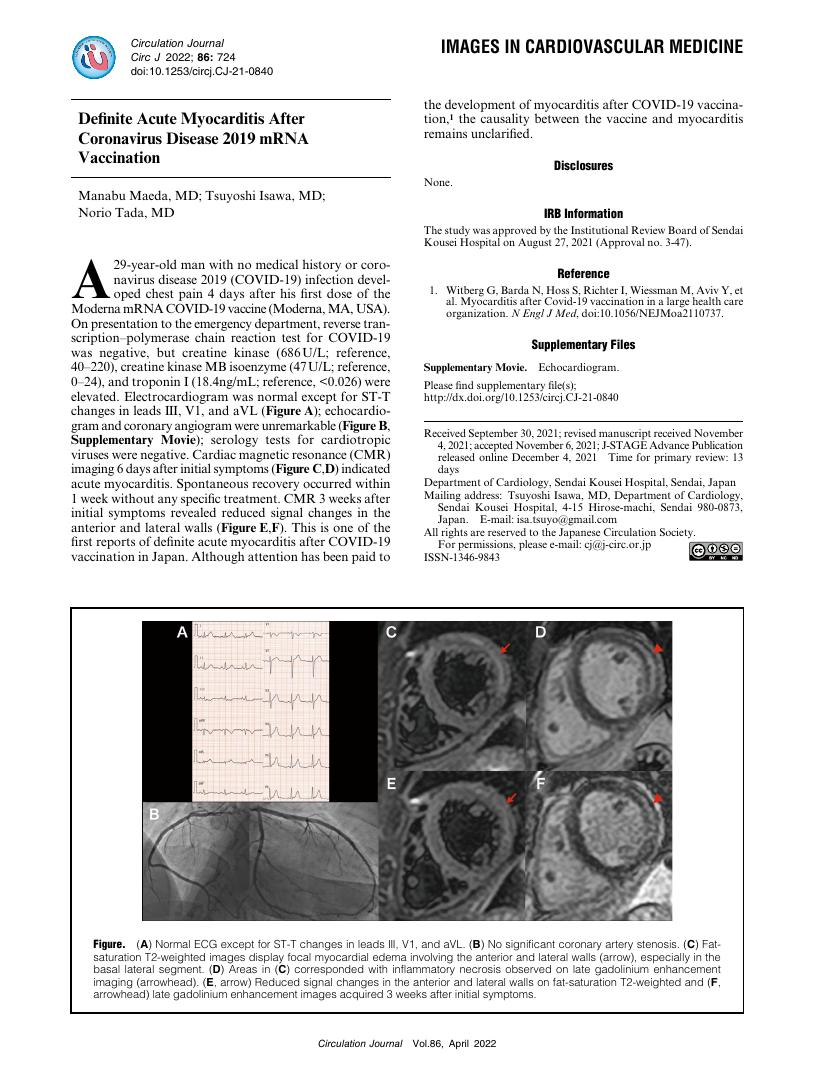- 著者
- Manabu Maeda Tsuyoshi Isawa Norio Tada
- 出版者
- The Japanese Circulation Society
- 雑誌
- Circulation Journal (ISSN:13469843)
- 巻号頁・発行日
- pp.CJ-21-0840, (Released:2021-12-04)
- 参考文献数
- 1
- 被引用文献数
- 2
- 著者
- Manabu Maeda Tsuyoshi Isawa Norio Tada
- 出版者
- The Japanese Circulation Society
- 雑誌
- Circulation Journal (ISSN:13469843)
- 巻号頁・発行日
- vol.86, no.4, pp.724, 2022-03-25 (Released:2022-03-25)
- 参考文献数
- 1
- 被引用文献数
- 2
- 著者
- Shintaro Togashi Tsuyoshi Isawa Taku Honda Kenichi Furuya Kazuhiro Yamaya Masataka Taguri Shigeru Toyoda
- 出版者
- The Japanese Circulation Society
- 雑誌
- Circulation Journal (ISSN:13469843)
- 巻号頁・発行日
- pp.CJ-23-0103, (Released:2023-05-16)
- 参考文献数
- 28
Background: Because the penetration of transvenous lead extraction (TLE) for cardiac implantable electronic device (CIED) infection has not been investigated in Japan, we conducted a population-based, retrospective, descriptive study to evaluate regional disparities in the use of TLE for CIED infection and the potential undertreatment of CIED infection using a nationwide insurance claims database.Methods and Results: Patients who underwent CIED implantation or generator exchange and TLE between April 2018 and March 2020 were identified. Moreover, the penetration ratio of TLE for CIED infection in each prefecture was estimated. CIED implantation and TLE were most prevalent in the age categories of 80–89 years (40.3%) and 80–89 years (36.9%), respectively. There was no correlation between the number of CIED implantations and that of TLE (rho=−0.087, 95% confidence interval −0.374 to 0.211, P=0.56). The median penetration ratio was 0.00 (interquartile range 0.00–1.29). Of the 47 prefectures, 6, comprising Okinawa, Miyagi, Okayama, Fukuoka, Tokyo, and Osaka, showed a penetration ratio ≥2.00.Conclusions: Our study data indicated great regional disparities in the penetration of TLE and potential undertreatment of CIED infection in Japan. Additional measures are needed to address these issues.
- 著者
- Hirotoshi Watanabe Takeshi Morimoto Ko Yamamoto Yuki Obayashi Masahiro Natsuaki Kyohei Yamaji Manabu Ogita Satoru Suwa Tsuyoshi Isawa Takenori Domei Kenji Ando Shojiro Tatsushima Hiroki Watanabe Masanobu Oya Kazushige Kadota Hideo Tokuyama Tomohisa Tada Hiroki Sakamoto Hiroyoshi Mori Hiroshi Suzuki Tenjin Nishikura Kohei Wakabayashi Takeshi Kimura for the STOPDAPT-2 ACS Investigators
- 出版者
- The Japanese Circulation Society
- 雑誌
- Circulation Journal (ISSN:13469843)
- 巻号頁・発行日
- vol.87, no.5, pp.657-668, 2023-04-25 (Released:2023-04-25)
- 参考文献数
- 28
Background: The REAL-CAD trial, reported in 2017, demonstrated a significant reduction in cardiovascular events with high-intensity statins in patients with chronic coronary syndrome. However, data are scarce on the use of high-intensity statins in Japanese patients with acute coronary syndrome (ACS).Methods and Results: In STOPDAPT-2 ACS, which exclusively enrolled ACS patients between March 2018 and June 2020, 1,321 (44.2%) patients received high-intensity statins at discharge, whereas of the remaining 1,667 patients, 96.0% were treated with low-dose statins. High-intensity statins were defined as the maximum approved doses of strong statins in Japan. The incidence of the cardiovascular composite endpoint (cardiovascular death, myocardial infarction, definite stent thrombosis, stroke) was significantly lower in patients with than without high-intensity statins (1.44% vs. 2.69% [log-rank P=0.025]; adjusted hazard ratio [aHR] 0.48, 95% confidence interval [CI] 0.24–0.94, P=0.03) and the effect was evident beyond 60 days after the index percutaneous coronary intervention (log-rank P=0.01; aHR 0.38, 95% CI 0.17–0.86, P=0.02). As for the bleeding endpoint, there was no significant difference between the 2 groups (0.99% vs. 0.73% [log-rank P=0.43]; aHR 0.96, 95% CI 0.35–2.60, P=0.93).Conclusions: The prevalence of high-intensity statins has increased substantially in Japan. The use of the higher doses of statins in ACS patients recommended in the guidelines was associated with a significantly lower risk of the primary cardiovascular composite endpoint compared with lower-dose statins.
- 著者
- Hirotoshi Watanabe Takeshi Morimoto Ko Yamamoto Yuki Obayashi Masahiro Natsuaki Kyohei Yamaji Manabu Ogita Satoru Suwa Tsuyoshi Isawa Takenori Domei Kenji Ando Shojiro Tatsushima Hiroki Watanabe Masanobu Oya Kazushige Kadota Hideo Tokuyama Tomohisa Tada Hiroki Sakamoto Hiroyoshi Mori Hiroshi Suzuki Tenjin Nishikura Kohei Wakabayashi Takeshi Kimura for the STOPDAPT-2 ACS Investigators
- 出版者
- The Japanese Circulation Society
- 雑誌
- Circulation Journal (ISSN:13469843)
- 巻号頁・発行日
- pp.CJ-22-0650, (Released:2022-12-08)
- 参考文献数
- 28
Background: The REAL-CAD trial, reported in 2017, demonstrated a significant reduction in cardiovascular events with high-intensity statins in patients with chronic coronary syndrome. However, data are scarce on the use of high-intensity statins in Japanese patients with acute coronary syndrome (ACS).Methods and Results: In STOPDAPT-2 ACS, which exclusively enrolled ACS patients between March 2018 and June 2020, 1,321 (44.2%) patients received high-intensity statins at discharge, whereas of the remaining 1,667 patients, 96.0% were treated with low-dose statins. High-intensity statins were defined as the maximum approved doses of strong statins in Japan. The incidence of the cardiovascular composite endpoint (cardiovascular death, myocardial infarction, definite stent thrombosis, stroke) was significantly lower in patients with than without high-intensity statins (1.44% vs. 2.69% [log-rank P=0.025]; adjusted hazard ratio [aHR] 0.48, 95% confidence interval [CI] 0.24–0.94, P=0.03) and the effect was evident beyond 60 days after the index percutaneous coronary intervention (log-rank P=0.01; aHR 0.38, 95% CI 0.17–0.86, P=0.02). As for the bleeding endpoint, there was no significant difference between the 2 groups (0.99% vs. 0.73% [log-rank P=0.43]; aHR 0.96, 95% CI 0.35–2.60, P=0.93).Conclusions: The prevalence of high-intensity statins has increased substantially in Japan. The use of the higher doses of statins in ACS patients recommended in the guidelines was associated with a significantly lower risk of the primary cardiovascular composite endpoint compared with lower-dose statins.
